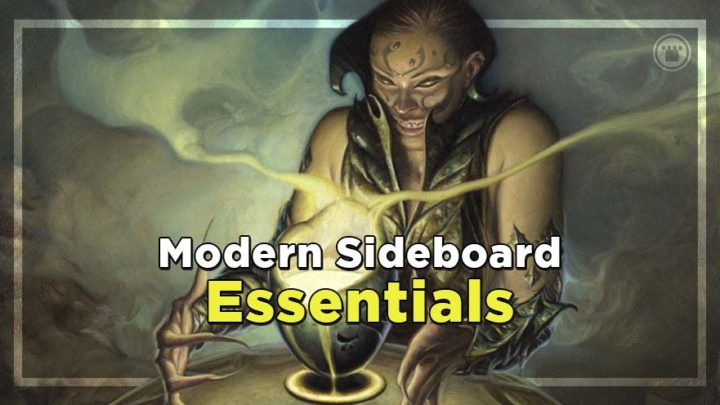Traditionally, there have been two primary schools of thought when it comes to building a sideboard in Modern: You can play narrow cards that are extremely powerful, or cards that are more broadly useful. Looking at the current metagame, it seems that Modern is moving away from broadly useful cards, and leaning into sideboard haymakers. These cards will often make or break your match-ups, and they can take over games single-handedly. If you’re looking for the best cards for your Modern sideboard, I’ve put together a list of 10 you should consider.
Engineered Explosives
Engineered Explosives may be the most tenured card on this list. While its popularity waxes and wanes with the metagame, it starts showing up in greater numbers as decks become more efficient.
Even decks that are high in one-mana creatures are often packing multiple copies of the powerful artifact. Why is that? First of all, Engineered Explosives gains a lot of utility when Lurrus of the Dream-Den lets you rebuy it from your graveyard; you can effectively lock a handful of decks out of the game. Modern also has more one-mana permanents than usual right now, and a lot more zero-mana permanents than usual. If you’re looking to beat Crashing Footfalls and Hammer Time, don’t leave home without Engineered Explosives.
Chalice of the Void
Chalice of the Void and Engineered Explosives often go hand-in-hand. When creatures are cheap, decks start packing cheaper spells to deal with them, and that’s when Chalice of the Void is at its strongest. The strength of both Crashing Footfalls and Living End in Modern makes Chalice of the Void a powerful sideboard option, as both cards have a mana value of zero.
But Chalice does more than just hate out cascade decks. It’s also powerful against a lot of the Lurrus decks, which tend to play upwards of 20 spells that cost one mana. Azorius Control, and Bring to Light Scapeshift are some of the notable decks that can afford to play Chalice in the main deck, but many more decks will have access to it after game one.
Mystical Dispute
Mystical Dispute is one of the more generic answers on this list. It’s at its best when your opponent’s deck is dense with blue cards, or if you’re looking to hit a single high-value target in blue. That being said, it’s versatile enough that you can use it as a three-mana Mana Leak against slower decks that you may struggle against.
You’ll mainly want this card if you’re looking to beat Izzet Tempo and Azorius Control. Mana efficiency matters a lot in both match-ups, especially when it comes to defending a threat. But you’ll also be more than happy to counter a Murktide Regent or Teferi, Hero of Dominaria.
Force of Vigor
Force of Vigor has been an important sideboard card for a while, but with the advent of Modern Horizons 2, its stock has soared. You’ll often see fairer green decks board in Force of Vigor to clean up Urza’s Saga, Construct tokens, Sigarda’s Aid, and Colossus Hammer. Unfair decks with access to green (usually graveyard strategies) can also use Force of Vigor to clear out hate pieces, like Rest in Peace and Grafdigger’s Cage.
Alpine Moon
Alpine Moon and Blood Moon both compete for this spot, but I gave Alpine Moon the nod because it’s more ubiquitous right now. One mana to destroy any Urza’s Sagas in play — and prevent any future ones from doing anything — is a great deal. Alpine Moon also puts in work against Tron; naming any of the Tron lands will prevent them from tapping for a collective seven mana. Alpine Moon looks to be a near lock for all but the most linear red decks.
Torpor Orb
Torpor Orb doesn’t have a long history of being a top tier sideboard card, but it has certainly made its mark since the release of Modern Horizons 2. It may be narrow, but it’s incredibly powerful against Elementals and other decks that lean on enter the battlefield effects. Not only does Torpor Orb turn off the abilities of most of Elementals’ creatures, but it makes Ephemerate much worse. It also effectively shuts off evoke, removing most of the deck’s early interaction.
Flusterstorm
Flusterstorm functions as a broad answer, but it’s especially good against Force of Negation. It’s also particularly effective against Crashing Footfalls and Living End because the cascade spell adds one to the storm count. (Those decks often have Force of Negation, too). You’ll find uses for this card against Azorius Control, Izzet Tempo, and a handful of other spell-heavy decks as well.
Sanctifier en-Vec
Sanctifier en-Vec is both brutal and multi-faceted. Protection from red and black means that Sanctifier dodges most common removal, and it’s a sturdy blocker against Ragavan decks. Dragon’s Rage Channeler never wants to see Sanctifier, either; removing red cards from the graveyard makes it fairly difficult to achieve delirium quickly. Dredge and Reanimator also have a hard time battling through Sanctifier because many of their payoffs are either black or red. Most white decks looking to attack will be a good home for Sanctifier en-Vec.
Soul-Guide Lantern
Soul-Guide Lantern gets the nod over Nihil Spellbomb here, though both cards are quite good. Most decks want a cheap way to interact with the graveyard these days, and Lantern is accessible to decks of any color. Urza’s Saga decks can play Soul-Guide Lantern as a tutor target. Lurrus decks can replay this from their graveyards; while they tend to favor Nihil Spellbomb, Soul-Guide Lantern is an all-star when Leyline of Sanctity is popular. Another nice caveat is that Soul-Guide Lantern provides asymmetrical graveyard hate, unlike Relic of Progenitus.
Sunset Revelry
Sunset Revelry is the latest anti-aggro tech — specifically anti-Burn. It bears a striking resemblance to another long-time sideboard card, Timely Reinforcements. But Revelry earns its keep based on its rate — it’s ⅔ of Timely Reinforcements, and it also has the card draw clause tacked on. It also tends to be easier to fit a two-mana spell into your curve; three-mana spells often come along too late. Sunset Revelry is already finding a home in defensively slanted white decks, and I expect that to be the case for a while.
Sideboarding is one of the most difficult and underappreciated skills in Magic. One way to begin building a strong sideboard is to make sure that you’re playing the best card for the job. Hopefully I’ve provided you with a good foundation in sideboarding today. If you’re looking for more ideas to build your Modern decks, check out our Modern Collection Essentials piece.
I’d love to know what your favorite sideboard card is! Let me know and leave any questions or comments for me on Twitter at @RappaciousOne. I’ll be back next week with more Modern content!

Michael Rapp is a Modern specialist who favors Thoughtseize decks. Magic sates his desire for competition and constant improvement.

